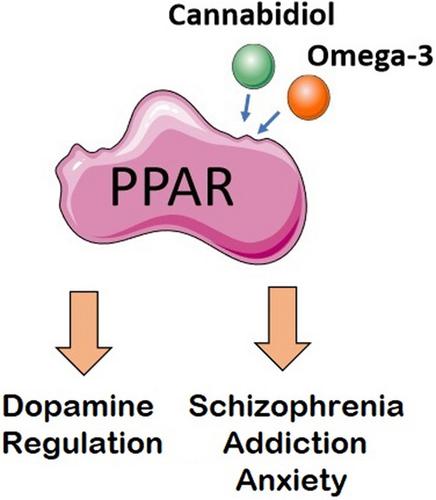当前位置:
X-MOL 学术
›
Eur. J. Neurosci.
›
论文详情
Our official English website, www.x-mol.net, welcomes your
feedback! (Note: you will need to create a separate account there.)
Functional interactions between cannabinoids, omega-3 fatty acids, and peroxisome proliferator-activated receptors: Implications for mental health pharmacotherapies
European Journal of Neuroscience ( IF 2.7 ) Pub Date : 2020-10-27 , DOI: 10.1111/ejn.15023 Tony Jung 1, 2 , Roger Hudson 1, 2 , Walter Rushlow 1, 2, 3 , Steven R. Laviolette 1, 2, 3
European Journal of Neuroscience ( IF 2.7 ) Pub Date : 2020-10-27 , DOI: 10.1111/ejn.15023 Tony Jung 1, 2 , Roger Hudson 1, 2 , Walter Rushlow 1, 2, 3 , Steven R. Laviolette 1, 2, 3
Affiliation

|
Cannabis contains a plethora of phytochemical constituents with diverse neurobiological effects. Cannabidiol (CBD) is the main non-psychotropic component found in cannabis that is capable of modulating mesocorticolimbic DA transmission and may possess therapeutic potential for several neuropsychiatric disorders. Emerging evidence also suggests that, similar to CBD, omega-3 polyunsaturated fatty acids may regulate DA transmission and possess therapeutic potential for similar neuropsychiatric disorders. Although progress has been made to elucidate the mechanisms underlying the therapeutic properties of CBD and omega-3s, it remains unclear through which receptor mechanisms they may produce their purported effects. Peroxisome proliferator-activated receptors are a group of nuclear transcription factors with multiple isoforms. PPARγ is an isoform activated by both CBD and omega-3, whereas the PPARα isoform is activated by omega-3. Interestingly, the activation of PPARγ and PPARα with selective agonists has been shown to decrease mesocorticolimbic DA activity and block neuropsychiatric symptoms similar to CBD and omega-3s, raising the possibility that CBD and omega-3s produce their effects through PPAR signaling. This review will examine the relationship between CBD, omega-3s, and PPARs and how they may be implicated in the modulation of mesocorticolimbic DAergic abnormalities and associated neuropsychiatric symptoms.
中文翻译:

大麻素、omega-3 脂肪酸和过氧化物酶体增殖物激活受体之间的功能相互作用:对心理健康药物疗法的影响
大麻含有大量具有多种神经生物学作用的植物化学成分。大麻二酚 (CBD) 是大麻中发现的主要非精神成分,能够调节皮质边缘 DA 传递,并可能具有治疗几种神经精神疾病的潜力。新出现的证据还表明,与 CBD 类似,omega-3 多不饱和脂肪酸可以调节 DA 的传递,并具有治疗类似神经精神疾病的潜力。尽管在阐明 CBD 和 omega-3s 治疗特性的潜在机制方面取得了进展,但仍不清楚它们可能通过哪些受体机制产生其所谓的效果。过氧化物酶体增殖物激活受体是一组具有多种亚型的核转录因子。PPARγ 是由 CBD 和 omega-3 激活的同种型,而 PPARα 同种型由 omega-3 激活。有趣的是,已显示用选择性激动剂激活 PPARγ 和 PPARα 可降低中脑边缘 DA 活性并阻断类似于 CBD 和 omega-3s 的神经精神症状,提高了 CBD 和 omega-3s 通过 PPAR 信号传导产生作用的可能性。本综述将研究 CBD、omega-3 和 PPAR 之间的关系,以及它们如何参与调节中脑边缘 DAergic 异常和相关的神经精神症状。已证明用选择性激动剂激活 PPARγ 和 PPARα 可降低中皮质边缘 DA 活性并阻断类似于 CBD 和 omega-3s 的神经精神症状,提高了 CBD 和 omega-3s 通过 PPAR 信号传导产生作用的可能性。本综述将研究 CBD、omega-3 和 PPAR 之间的关系,以及它们如何参与调节中脑边缘 DAergic 异常和相关的神经精神症状。已证明用选择性激动剂激活 PPARγ 和 PPARα 可降低中皮质边缘 DA 活性并阻断类似于 CBD 和 omega-3s 的神经精神症状,提高了 CBD 和 omega-3s 通过 PPAR 信号传导产生作用的可能性。本综述将研究 CBD、omega-3 和 PPAR 之间的关系,以及它们如何参与调节中脑边缘 DAergic 异常和相关的神经精神症状。
更新日期:2020-10-27
中文翻译:

大麻素、omega-3 脂肪酸和过氧化物酶体增殖物激活受体之间的功能相互作用:对心理健康药物疗法的影响
大麻含有大量具有多种神经生物学作用的植物化学成分。大麻二酚 (CBD) 是大麻中发现的主要非精神成分,能够调节皮质边缘 DA 传递,并可能具有治疗几种神经精神疾病的潜力。新出现的证据还表明,与 CBD 类似,omega-3 多不饱和脂肪酸可以调节 DA 的传递,并具有治疗类似神经精神疾病的潜力。尽管在阐明 CBD 和 omega-3s 治疗特性的潜在机制方面取得了进展,但仍不清楚它们可能通过哪些受体机制产生其所谓的效果。过氧化物酶体增殖物激活受体是一组具有多种亚型的核转录因子。PPARγ 是由 CBD 和 omega-3 激活的同种型,而 PPARα 同种型由 omega-3 激活。有趣的是,已显示用选择性激动剂激活 PPARγ 和 PPARα 可降低中脑边缘 DA 活性并阻断类似于 CBD 和 omega-3s 的神经精神症状,提高了 CBD 和 omega-3s 通过 PPAR 信号传导产生作用的可能性。本综述将研究 CBD、omega-3 和 PPAR 之间的关系,以及它们如何参与调节中脑边缘 DAergic 异常和相关的神经精神症状。已证明用选择性激动剂激活 PPARγ 和 PPARα 可降低中皮质边缘 DA 活性并阻断类似于 CBD 和 omega-3s 的神经精神症状,提高了 CBD 和 omega-3s 通过 PPAR 信号传导产生作用的可能性。本综述将研究 CBD、omega-3 和 PPAR 之间的关系,以及它们如何参与调节中脑边缘 DAergic 异常和相关的神经精神症状。已证明用选择性激动剂激活 PPARγ 和 PPARα 可降低中皮质边缘 DA 活性并阻断类似于 CBD 和 omega-3s 的神经精神症状,提高了 CBD 和 omega-3s 通过 PPAR 信号传导产生作用的可能性。本综述将研究 CBD、omega-3 和 PPAR 之间的关系,以及它们如何参与调节中脑边缘 DAergic 异常和相关的神经精神症状。











































 京公网安备 11010802027423号
京公网安备 11010802027423号